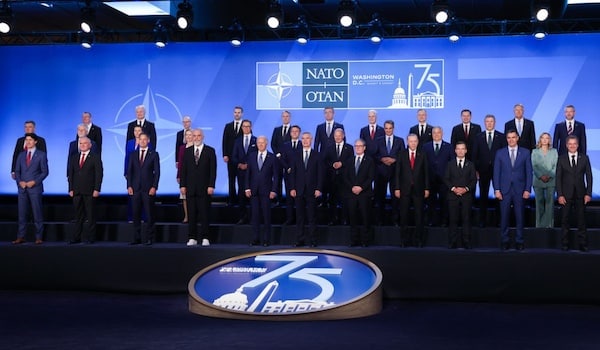NATO’s expansionary military targets are deeply at odds with the need to scale down global emissions to avoid deepening the climate crisis. NATO’s goal of dedicating 2% of GDP to military spending is set to exacerbate climate breakdown by diverting billions of dollars away from essential climate investment and significantly increasing CO2 emissions.
By its own admission, NATO recognises that climate change increasingly threatens its missions and operations worldwide. In Iraq, extreme heat and frequent dust storms have disrupted operations. In Kosovo, wildfires and severe flooding have become more common. In the Arctic, melting ice and unpredictable weather have complicated navigation and logistics, while in Africa, prolonged droughts and desertification destabilise regions and exacerbate conflicts over resources. NATO’s Mediterranean missions are also affected by rising sea levels and hotter temperatures, threatening coastal installations and impacting personnel health.
In 2023 alone, NATO members collectively spent $1.26 trillion on their military, an increase of $126 billion on 2022. This staggering sum could have covered twelve years of the promised, and still not delivered, $100 billion annual climate finance to support low-and middle-income countries. Rich, polluting nations are now three years overdue on their commitment to mobilise this $100 billion annually. However, the reality is even grimmer. According to Oxfam’s Climate Finance Shadow Report 2023, while donors claimed to have mobilised $83.3 billion in 2020, the actual value is likely closer to $24.5 billion. The inflated figure includes projects with overstated climate objectives and loans cited at their face value, not accounting for the financial burden these loans place on already indebted countries.
Military expenditures directly contribute to environmental degradation through increased carbon emissions. NATO’s overall military spending in 2023 of $1.34 trillion produced an estimated 233 million metric tonnes of CO2 equivalent (tCO2e). This is more than Colombia’s or Qatar’s annual GHG emissions. The UK, along with the U.S., Poland, Greece, Estonia, Lithuania, Finland, and Latvia, have gone beyond the 2% target. Earlier this year, then Prime Minister Rishi Sunak increased defence spending to 2.5% of the GDP in 2024. The current Labour government has retained this policy.
The current global situation is dire. As the world edges closer to irreversible environmental change, armed conflicts and violence are escalating. Between 2021 and 2023, casualties surged dramatically due to four major conflicts: the civil wars in Ethiopia’s Tigray region and Sudan, the Russian invasion of Ukraine, and the ongoing genocide in Gaza. During this period, no fewer than 59 state-based conflicts were recorded across 34 countries: the highest level since 1946.
NATO’s priorities are morally indefensible on a number of levels. In terms of our environment, while NATO countries pour billions into military budgets, contributing significantly to environmental degradation, they fail to meet their climate finance commitments.

